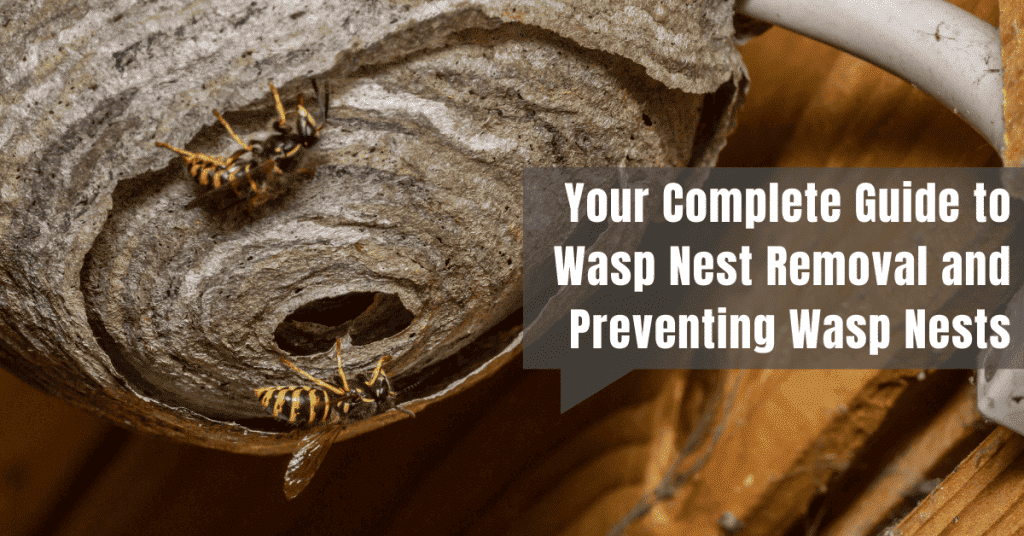
Wasps play an important ecological role, but their nests can sometimes cause safety concerns that require professional removal. This comprehensive guide covers everything you need to know about understanding wasps, identifying and removing nests, and preventing future infestations.
Table of Contents
Understanding Wasps and Their Nests
There are three common species of wasp found in most areas of the UK:
- Common wasps (Vespula vulgaris)
- German wasps (Vespula germanica)
- Tree wasps (Dolichovespula sylvestris)
These social wasps live in colonies and build intricate paper nests out of chewed wood pulp. Nests are often built in holes, cavities, or sheltered areas like attics, sheds, bushes, trees, and walls.
A typical wasp nest starts out small in the spring when queens emerge from hibernation and begin laying eggs. Nests grow rapidly over the summer as more wasps hatch to expand and maintain the nest.
By late August, colonies can reach over 5,000 wasps in size. Nests reach their peak soon after and then begin to decline going into autumn and winter. The queen stops laying eggs, the colony dies out, and the nest is not reused the following year.
The Wasp Life Cycle
Spring Emergence
- Overwintered queens – In March or April, fertilised queens emerge from hibernation sites like sheds, hollow trees, and attics.
- Nest initiation – The queens begin gathering fibres from old wood, fences, dead sticks, and similar materials to build starter nest cells.
- First eggs laid – Once the rudimentary nest is started, the queen begins laying eggs within its cells. She also secretes chemicals that prevent other foundress queens from joining the nest once her eggs are present.
Summer Growth
- Larvae hatch – The first eggs laid will develop into sterile female workers who tend to and expand the nest. After eggs hatch into larvae, the queen feeds them with proteins and carbohydrates.
- Pupation – After about 2 weeks, larvae spin a silken cocoon to pupate over 6-16 days before emerging from cells as adult wasps.
- Workforce builds up – By mid to late summer, the nest size grows exponentially, reaching several thousand workers who continually expand the nest framework. The queen retires from nest building and egg-laying duties at this stage.
- Production of reproductive wasps – Some larvae develop into queens and males that leave the colony in late summer to mate and hibernate as the founding queens for next year’s nest establishment cycle.
Late Summer Decline
- Founding queens depart – Newly mated queens leave over a short span from late August to early September, seeking protected sites to overwinter as the solitary foundress queens. Males quickly die off after mating.
- No new eggs – The existing queen stops laying fertilised eggs altogether once new queens depart to propagate the next generation.
- Abandoned nest – By late September, the remaining wasp workers, males, and founding queen have died, leaving the vacated nest to degrade naturally over autumn and winter. It will not be reused.
Identifying and Locating Wasp Nests
Detecting nests early improves the chances of quick, effective treatment. Telltale signs of an active wasp nest include:
- Numerous wasps buzzing around a specific area
- Wasps flying in and out of a small opening like a cavity, hole, or crevice
- Rapidly expanding nest structure visible on a shed, tree branch, or building overhang
- Large numbers of wasps in the area attracted to human foods and waste
While wasp nests can occasionally form in exposed aerial locations, some of the most common sheltering nest sites around homes include:
- Attics
- Sheds
- Old rodent burrows
- Eaves
- Trees
- Dense hedges and vegetation
- Cavity walls
- Gaps around window and door frames
Nests are often concealed from easy view, but careful observation of wasp flight paths can help pinpoint nest access holes. Landscaping and maintenance activities also frequently disturb hidden nests.
Safe Removal of Wasp Nests
Trying to remove a large, established wasp nest carries significant risks of getting stung. Wasp venom can cause severe allergic reactions in sensitive individuals. Facial areas tend to provoke the most aggressive defensive response if wasps feel the nest area is threatened.
For effective treatment with minimal safety risks, professional pest control is strongly recommended for eliminating accessible nests and wasp nest removal within 21 metres of human activity.
Risks of DIY Wasp Nest Removal
Attempting to personally exterminate a wasp nest comes with these dangers:
- Multiple painful stings resulting in swelling, welts, and potential allergic reaction
- Difficulty fully reaching nests in hard-to-access areas
- Inability to withstand aggressive mass attacks
- Improper application of low-quality, store-bought pesticides
- Lack of follow-up to confirm nest elimination
- Later nest reformation if the queen or developing larvae survive initial efforts
Without proper protective equipment, training, commercial-grade pesticides, and removal experience, DIY wasp nest removal methods will almost certainly fail to fully destroy a large, established wasp nest.
Benefits of Professional Wasp Nest Removal
Reputable pest control technicians have specialised tools, products, and procedures to remove nests in the safest, most effective manner possible:
- Adherence to quality standards associations
- Extensive training and certification
- High-reach equipment for aerial/accessibility challenges
- Maximum-strength rapid knockdown sprays
- Protective gear to prevent stings during removal
- Strategic step-by-step treatment plans
- Preservation of beneficial bee populations
- Post-treatment inspection and respray if needed
- Advice tailored to your property’s risks
Hiring a licensed professional takes the guesswork and liability out of tackling nuisance wasps. Technicians will assess your situation, formulate a comprehensive plan of attack, and assume all risks until the infestation has been certified as eliminated.
Preventing Wasp Nests
While spring and summer are peak seasons for nuisance wasps, taking preventative measures early in the year is key to reducing nest establishment:
Early Detection
- Thoroughly inspect overwintering habitat in sheds, garages, attics, etc. for emerging foundress queens and initial nest cells in March/April.
- Monitor outdoor areas around suitable nesting sites in spring for early nest foundations.
- Identify key points of entry like small gaps, holes, and cavities that need sealing.
Prevention Tips
- Install fine mesh screens over eaves, vents, chimneys, and potential access holes.
- Seal cracks/crevices with foam filler, wood, metal guards, or other excluders.
- Repair damaged roof areas. Avoid exposed wood and peeling surfaces.
- Prune back vegetation touching buildings. Remove dead branches, stumps, and timber debris.
- Clean food waste quickly. Use covered bins; avoid compost heaps.
- Use fake nest decoys as deterrents. Relocate harmless bait nests regularly.
Early Chemical Prevention
Applying a short residual pesticide dust or liquid spray treatment inside newly detected nests kill developing larvae the nests. However, professional expertise is still recommended for product selection and proper application.
Professional Wasp Removal Services in the UK
Seeking out a reputable pest control provider for swift removal of active wasp nests around your property is the safest, most reliable solution for wasp nest removal.
What to Expect From Professional Services
- Thorough site inspection to locate nests
- Strategic step-by-step treatment plan explanation
- High-reach extension equipment for hard-to-access nests
- Application of fast knockdown, low-risk pesticide sprays
- Post-treatment inspection to confirm elimination
- Written report with photos, treatment details, and prevention advice
Choosing the Right Pest Control Service
- Verify credentials & licences to operate in your area
- Check reviews and complaints with business review sites
- Compare service scope & pricing to meet your situation
- Ask about humane practices, environmental impact mitigation, and pollinator safety protocols
- Reputable pest professionals should provide effective, lasting relief from nuisance wasps while protecting beneficial insect populations.
Conclusion
Wasps fill an important predatory niche for controlling garden and agricultural pests. Their nesting behaviours only become a pressing concern when located too close to human activity.
Seeking professional pest removal services balances safety for people and pets with environmental protection using responsible, sustainable practices to discourage nesting. Preventive pest control measures are essential for reducing annual wasp infestations as well.
This guide covers key aspects of understanding wasp nesting cycles, detecting active nest locations, safely removing established hives, and proactively excluding initial nest building activity around structures through inspection, exclusion, and pest control deterrence.
Protecting family members from stings must be balanced with supporting beneficial wasp populations vital to local ecosystems. By partnering with trained specialists, nuisance nest removal and prevention can integrate human interests with sustainable environmental practices for managing wasps and safe wasp nest removal.

